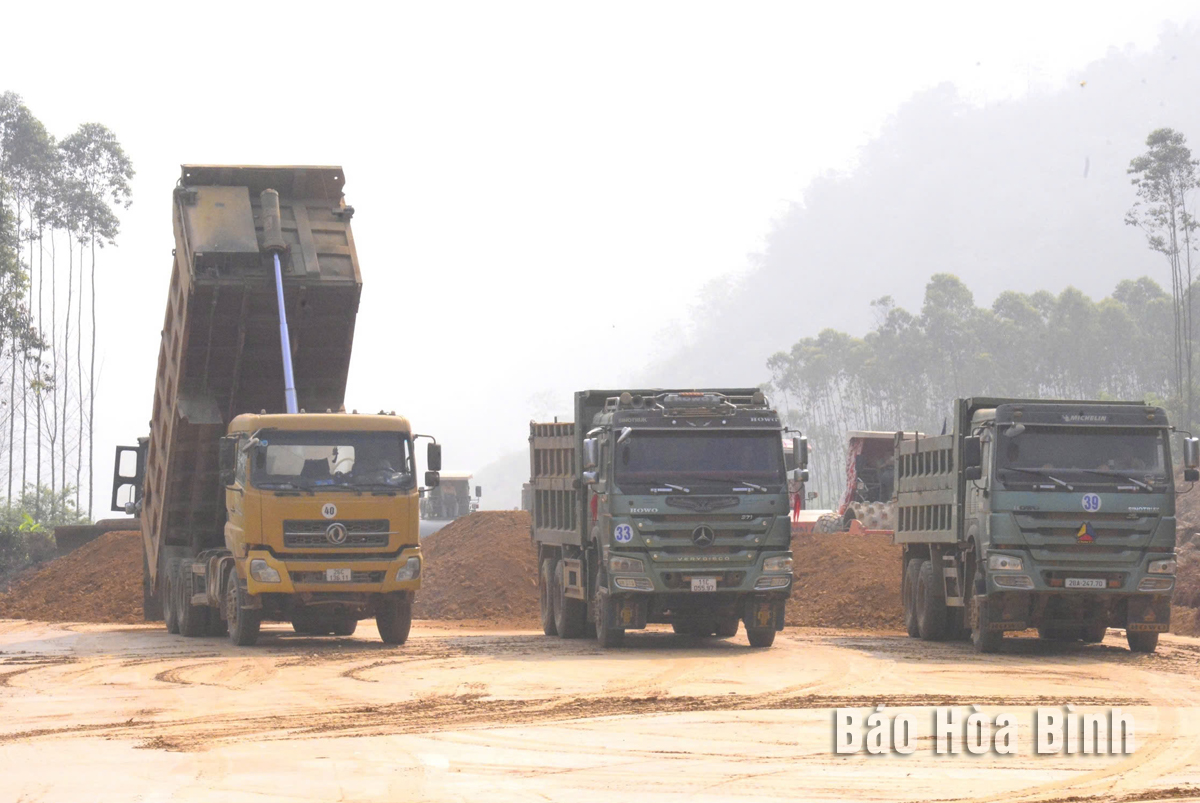
Amid efforts to streamline the administrative apparatus, Hoa Binh province has intensified measures to address challenges in land clearance, resettlement support, and infrastructure investment, aiming to speed up the progress of key projects.
Contractors work on the Hoa Binh – Moc Chau expressway project's section running through Cao Son commune, Da Bac district.
In recent times, standing members of the provincial Party Committee, members of the Steering Committee for key projects of the province have intensified inspections and urged solutions to bottlenecks and obstacles. They have taken decisive direction, setting clear timelines and task plans to accelerate the implementation of projects.
The construction of the Hoa Binh – Moc Chau expressway project (section km 19 to km 53) is required to complete one year ahead of the schedule, so land clearance, resettlement, and construction efforts are being carried out with the utmost urgency and focus.
Nguyen Tran Anh, Secretary of the Mai Chau district Party Committee, stated that the district has mobilised the entire political system to engage in public outreach, calling on affected residents to support the project. In particular, the district has closely coordinated with departments, sectors, and the investor to implement compensation, land clearance, and resolve land-related procedural issues. As a result, local residents have fully agreed to hand over 100% of the required land for construction.
The expanded Hoa Lac – Hoa Binh road project, which includes the improvement of National Highway 6 from Xuan Mai to Hoa Binh, is one of the strategic projects aimed at shortening travel time between Hanoi and the northwestern provinces. After years of coordination with relevant ministries and sectors to address challenges and propose investment plans, the project has been approved by the Government under a public-private partnership form.
The province established a special task force led by the Vice Chairman of the provincial People’s Committee to direct the implementation of the project, especially streamlining administrative procedures and preparing cleared land for the project's groundbreaking on July 1, 2025.
Meanwhile, the Canh Tang reservoir project has a total investment of over 3.9 trillion VND sourced from the state budget, and managed by the Ministry of Agriculture and Environment. This project plays a vital role in the locality’s socio-economic development, particularly for Lac Son and Yen Thuy districts in particular. Many items of the project are progressing as planned, with its main structure is expected to be completed by April 30, 2025.
By late 2024, Hoa Binh implemented 14 key projects under the supervision of the provincial Steering Committee for key projects, including one public-private partnership (PPP) project, five transportation and irrigation projects using the public investment, and eight commercial investment projects utilising non-state capital. The total investment capital for these key projects amounted to nearly 87.2 trillion VND.
In 2025, the province reviewed and added 10 new projects using non-state capital (including one FDI project), raising the total number of key projects to 24 with total registered investment capital of about 101.9 trillion VND.
So far, 10 projects have already commenced and require accelerated implementation, while 12 others are scheduled to start in this year, and three projects are expected to begin after 2025.
In Lac Thuy district, communes have been succeeded in promoting their One Commune-One Product (OCOP) products while others are still struggling to position their typical farming products in market. Some communes in the district still fail to have their products met OCOP programme’s requirements, while others have seen their certifications expired.
The inspectorate agency of Hoa Binh province has issued Official Dispatch No. 1090/TTr-PCTN to provincial departments, agencies, localities, business associations, enterprises, and investors regarding measures to improve informal component indexes of the Provincial Competitiveness Index (PCI).
Hoa Binh is taking concrete steps to improve its investment environment, with a strong focus on supporting businesses, settling obstacles for strategic investors, and creating opportunities for robust development in the coming years.
Under the blazing early summer sun, the construction site of Nhuan Trach Industrial Park (IP) in Luong Son district is abuzz with activities from dawn to dusk, a testament to the determination of the investor to meet their construction targets on schedule.



